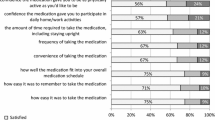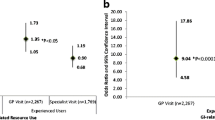Abstract
Purpose
To examine the psychometric properties and validity of the 8-item Osteoporosis-Specific Morisky Medication Adherence Scale (OS-MMAS-8) in postmenopausal women prescribed bisphosphonates (BPs) for at least 15 months.
Methods
A random sample of women aged ≥55 years with osteoporosis prescribed daily or weekly BPs was identified. Pharmacy fill data were extracted to calculate the medication possession ratio (MPR). Eligible women were stratified by low (<0.50), medium (0.50–0.79), or high (≥0.80) MPR, with the a priori goal of recruiting 133 participants in each group. OS-MMAS-8 scores can range from 0 to 8 and were categorized as low (<6), medium (6 to <8), and high (8) adherence. Internal consistency reliability (Cronbach’s alpha), test–retest reliability [intraclass correlation coefficients (ICCs)] and convergent validity (correlating OS-MMAS-8 with MPR and other self-reported measures) were assessed.
Results
A total of 400 women out of 449 respondents reported that they were still taking their BPs at the time of the survey and completed OS-MMAS-8. Overall, 38.5, 34.3, and 27.3 % of participants had low, medium, and high OS-MMAS-8 scores, respectively. The mean (SD) MPRs according to OS-MMAS-8 scores (<6, 6 to <8 and 8) were 56.9 (22.6), 69.0 (24.9), and 76.7 (26.4), respectively. The correlation between OS-MMAS-8 and MPR was 0.36; p < 0.0001. Cronbach’s alpha was 0.74, and the ICC was 0.83 (95 % CI 0.76–0.88).
Conclusions
OS-MMAS-8 has acceptable psychometric properties for assessing medication adherence in postmenopausal women prescribed therapy for osteoporosis. Additional studies are needed to investigate the psychometric properties of OS-MMAS-8 in other settings and populations.

Similar content being viewed by others
References
National Osteoporosis Foundation. (2013). What is osteoporosis? Retrieved June 19, 2013, from http://www.nof.org/articles/7.
Rosen, C. J. (2005). Clinical practice. Postmenopausal osteoporosis. The New England Journal of Medicine, 353(6), 595–603.
Watts, N. B., Bilezikian, J. P., Camacho, P. M., Greenspan, S. L., Harris, S. T., Hodgson, S. F., et al. (2010). American association of clinical endocrinologists medical guidelines for clinical practice for the diagnosis and treatment of postmenopausal osteoporosis: Executive summary of recommendations. Endocrine Practice, 16(6), 1016–1019.
Black, D. M., Delmas, P. D., Eastell, R., Reid, I. R., Boonen, S., Cauley, J. A., et al. (2007). Once-yearly zoledronic acid for treatment of postmenopausal osteoporosis. The New England Journal of Medicine, 356(18), 1809–1822.
Halpern, R., Becker, L., Iqbal, S. U., Kazis, L. E., Macarios, D., & Badamgarav, E. (2011). The association of adherence to osteoporosis therapies with fracture, all-cause medical costs, and all-cause hospitalizations: A retrospective claims analysis of female health plan enrollees with osteoporosis. Journal of Managed Care Pharmacy, 17(1), 25–39.
Siris, E. S., Selby, P. L., Saag, K. G., Borgstrom, F., Herings, R. M., & Silverman, S. L. (2009). Impact of osteoporosis treatment adherence on fracture rates in North America and Europe. The American Journal of Medicine, 122(2 Suppl), S3–S13.
Weycker, D., Macarios, D., Edelsberg, J., & Oster, G. (2007). Compliance with osteoporosis drug therapy and risk of fracture. Osteoporosis International, 18(3), 271–277.
Kothawala, P., Badamgarav, E., Ryu, S., Miller, R. M., & Halbert, R. J. (2007). Systematic review and meta-analysis of real-world adherence to drug therapy for osteoporosis. Mayo Clinic Proceedings, 82(12), 1493–1501.
Weycker, D., Macarios, D., Edelsberg, J., & Oster, G. (2006). Compliance with drug therapy for postmenopausal osteoporosis. Osteoporosis International, 17(11), 1645–1652.
Osterberg, L., & Blaschke, T. (2005). Adherence to medication. The New England Journal of Medicine, 353(5), 487–497.
Hess, L. M., Raebel, M. A., Conner, D. A., & Malone, D. C. (2006). Measurement of adherence in pharmacy administrative databases: A proposal for standard definitions and preferred measures. The Annals of Pharmacotherapy, 40(7–8), 1280–1288.
Reynolds, K., Viswanathan, H. N., O’Malley, C. D., Muntner, P., Harrison, T. N., Cheetham, T. C., et al. (2012). Psychometric properties of the osteoporosis-specific Morisky Medication Adherence Scale in postmenopausal women with osteoporosis newly treated with bisphosphonates. The Annals of Pharmacotherapy, 46(5), 659–670.
Koebnick, C., Langer-Gould, A. M., Gould, M. K., Chao, C. R., Iyer, R. L., Smith, N., et al. (2012). Sociodemographic characteristics of members of a large, integrated health care system: Comparison with US Census Bureau Data. The Permanente Journal, 16(3), 37–41.
Sikka, R., Xia, F., & Aubert, R. E. (2005). Estimating medication persistency using administrative claims data. The American Journal of Managed Care, 11(7), 449–457.
Steiner, J. F., & Prochazka, A. V. (1997). The assessment of refill compliance using pharmacy records: Methods, validity, and applications. Journal of Clinical Epidemiology, 50(1), 105–116.
Horne, R., Weinman, J., & Hankins, M. (1999). The beliefs about medicines questionnaire: The development and evaluation of a new method for assessing the cognitive representation of medication. Psychology and Health, 14, 1–24.
Risser, J., Jacobson, T. A., & Kripalani, S. (2007). Development and psychometric evaluation of the Self-efficacy for Appropriate Medication Use Scale (SEAMS) in low-literacy patients with chronic disease. Journal of Nursing Measurement, 15(3), 203–219.
Dimenas, E., Glise, H., Hallerback, B., Hernqvist, H., Svedlund, J., & Wiklund, I. (1993). Quality of life in patients with upper gastrointestinal symptoms. An improved evaluation of treatment regimens? Scandinavian Journal of Gastroenterology, 28(8), 681–687.
Atkinson, M. J., Sinha, A., Hass, S. L., Colman, S. S., Kumar, R. N., Brod, M., et al. (2004). Validation of a general measure of treatment satisfaction, the Treatment Satisfaction Questionnaire for Medication (TSQM), using a national panel study of chronic disease. Health and Quality of Life Outcomes, 2, 12.
Ware, J., Jr, Kosinski, M., & Keller, S. D. (1996). A 12-Item Short-Form Health Survey: Construction of scales and preliminary tests of reliability and validity. Medical Care, 34(3), 220–233.
Krousel-Wood, M., Islam, T., Webber, L. S., Re, R. N., Morisky, D. E., & Muntner, P. (2009). New medication adherence scale versus pharmacy fill rates in seniors with hypertension. The American Journal of Managed Care, 15(1), 59–66.
Morisky, D. E., Ang, A., Krousel-Wood, M., & Ward, H. J. (2008). Predictive validity of a medication adherence measure in an outpatient setting. Journal of Clinical Hypertension, 10(5), 348–354.
Horne, R., Buick, D., Fisher, M., Leake, H., Cooper, V., & Weinman, J. (2004). Doubts about necessity and concerns about adverse effects: Identifying the types of beliefs that are associated with non-adherence to HAART. International Journal of STD and AIDS, 15(1), 38–44.
Revicki, D. A., Wood, M., Wiklund, I., & Crawley, J. (1998). Reliability and validity of the Gastrointestinal Symptom Rating Scale in patients with gastroesophageal reflux disease. Quality of Life Research, 7(1), 75–83.
Cronbach, L. J. (1951). Coefficient alpha and internal structure tests. Psychometrika, 16, 297–334.
Nunnaly, J. (1978). Psychometric theory. New York: McGraw-Hill.
Leidy, N. K., Revicki, D. A., & Geneste, B. (1999). Recommendations for evaluating the validity of quality of life claims for labeling and promotion. Value in Health, 2(2), 113–127.
Lin, L. I. (1989). A concordance correlation coefficient to evaluate reproducibility. Biometrics, 45(1), 255–268.
Landis, J. R., & Koch, G. G. (1977). The measurement of observer agreement for categorical data. Biometrics, 33(1), 159–174.
Cohen, J. (1988). Statistical power analysis for the behavioral sciences (2nd ed.). New York: Lawrence Erlbaum.
Bentler, P. M. (1990). Comparative fit indexes in structural models. Psychological Bulletin, 107(2), 238–246.
Browne, M., & Cudeck, R. (1992). Alternative ways of assessing model fit. Sociological Methods & Research, 21, 230–259.
Hatcher, L. (1994). A step-by-step approach to using the SAS system for factor analysis and structural equation modeling. Cary, NC: SAS Institute.
Hu, L., & Bentler, P. M. (1998). Fit indices in covariance structure modeling: Sensitivity to underparameterized model misspecification. Psychological Methods, 3, 424–453.
Karve, S., Cleves, M. A., Helm, M., Hudson, T. J., West, D. S., & Martin, B. C. (2009). Good and poor adherence: Optimal cut-point for adherence measures using administrative claims data. Current Medical Research and Opinion, 25(9), 2303–2310.
Breuil, V., Cortet, B., Cotte, F. E., Arnould, B., Dias-Barbosa, C., Gaudin, A. F., et al. (2012). Validation of the adherence evaluation of osteoporosis treatment (ADEOS) questionnaire for osteoporotic post-menopausal women. Osteoporosis International, 23(2), 445–455.
Haynes, R. B., Taylor, D. W., Sackett, D. L., Gibson, E. S., Bernholz, C. D., & Mukherjee, J. (1980). Can simple clinical measurements detect patient noncompliance? Hypertension, 2(6), 757–764.
Ho, P. M., Bryson, C. L., & Rumsfeld, J. S. (2009). Medication adherence: Its importance in cardiovascular outcomes. Circulation, 119(23), 3028–3035.
DiMatteo, M. R. (2004). Variations in patients’ adherence to medical recommendations: A quantitative review of 50 years of research. Medical Care, 42(3), 200–209.
Curtis, J. R., Cai, Q., Wade, S. W., Stolshek, B. S., Adams, J. L., Balasubramanian, A., et al. (2013). Osteoporosis medication adherence: Physician perceptions vs. patients’ utilization. Bone, 55(1), 1–6.
Acknowledgments
We acknowledge the exemplary contributions of the study staff at the Department of Research & Evaluation, Kaiser Permanente Southern California (Alexander Carruth, Kimberly Saylor, Rong Wei, and Sandra Zakai). We thank David Macarios of Amgen Inc. for his insights on the Needs–Concerns Differential analyses. This study was funded by a contractual agreement between Kaiser Permanente Southern California and Amgen Inc., Thousand Oaks, CA.
Conflict of interest
Drs. O’Malley, Viswanathan and Grauer are employees of Amgen Inc. and own stock in Amgen Inc. Drs. Muntner, Gold, Silverman, and Morisky have served as advisors for Amgen Inc. Drs. Muntner, Gold and Silverman have served as consultants for Amgen Inc. Drs. Reynolds and Muntner received research support from Amgen Inc. Dr. Silverman has served as an advisor for Lilly, Novartis and Pfizer/Wyeth. Dr. Silverman has served as a consultant for Genentech, Lilly, Novartis and Pfizer/Wyeth. Dr. Silverman has received research support from Lilly and Pfizer/Wyeth. This study was funded by a contractual agreement between Kaiser Permanente Southern California and Amgen Inc., Thousand Oaks, CA.
Author information
Authors and Affiliations
Corresponding author
Electronic supplementary material
Below is the link to the electronic supplementary material.
Rights and permissions
About this article
Cite this article
Reynolds, K., Viswanathan, H.N., Muntner, P. et al. Validation of the Osteoporosis-Specific Morisky Medication Adherence Scale in long-term users of bisphosphonates. Qual Life Res 23, 2109–2120 (2014). https://doi.org/10.1007/s11136-014-0662-3
Accepted:
Published:
Issue Date:
DOI: https://doi.org/10.1007/s11136-014-0662-3




